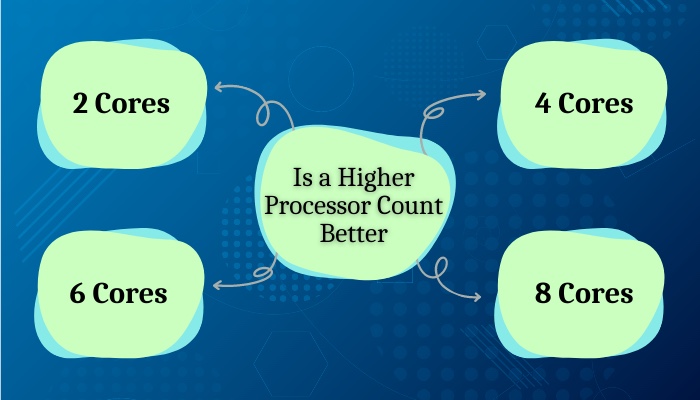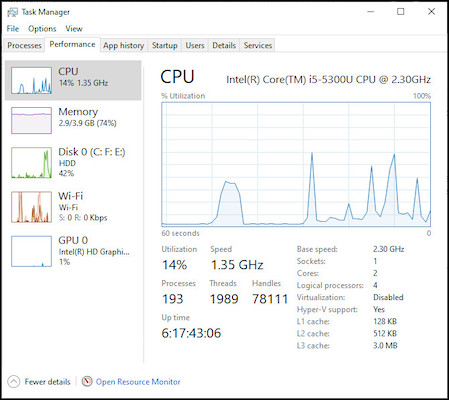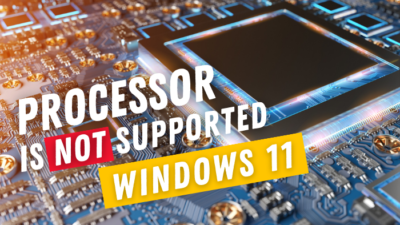Processor count is the term to measure the number of cores in a CPU. Each core is a tiny processor inside a larger chipset that can execute any instructions independently.
A single-core processor can deal with only one instruction at once. However, manufacturers manage to embed multiple cores inside a chipset, which dramatically changed the computing industry.
Let’s dive into this article to understand what processor count means and how it impacts on computer performance.
What Does Processor Count Stand for?
The processor count stands for the number of cores available in a processor. For instance, a dual-core processor has two cores, and a quad-core processor has four cores. Furthermore, a CPU core can consist of two virtual processing units known as threads.
In the early ages, computers used to have one core that handled all the tasks. However, one core was not sufficient to deal with multiple programs.
In order to eliminate this issue, it was necessary to introduce new technologies that can efficiently manage multitasking without producing a lot of heat.
As a single core is not sufficient to run multiple programs simultaneously, the necessity of using multicore CPUs was determined. Hence, the recent CPUs come with 2, 4, 6, or 8 cores that are efficient for multitasking.
Along with multitasking, more CPU cores allow running the computer faster. Though, you should also consider the CPUs clock speed (measured in gigahertz) for a faster experience.
Is a Higher Processor Count Better?
A higher processor count (a CPU with multiple cores) can perform better than a single-core CPU that offers the same base clock speed. Multiple cores can efficiently manage several programs at once, which increases performance with greater ease.
For a better understanding of comparative CPU cores, consider the following section.
2 Cores
A CPU with 2 cores (also known as dual-core) is the most used CPU in modern computing. Dual-core processors are budget-friendly and can produce significantly low power compared to other processors.
4 Cores
Quad-core CPUs are the most efficient processor for multitasking. A quad-core processor can easily handle most of the daily tasks, such as streaming, playing games, and browsing the internet with multiple tabs.
However, quad-core CPUs may struggle to manage multiple programs simultaneously.
6 Cores
A CPU with six individual cores (Hexa-core) can efficiently handle most of the advanced tasks. Hexa-core CPUs are more than enough for basic users. You can easily run multiple programs without sacrificing performance.
8 Cores
An octa-core processor is the ultimate machine for an individual that can deal with the most advanced tasks. This type of processor is used by video editors, animators, and computer engineers.
By reviewing the most used processors, we can undoubtedly determine the difference in performance and usability. However, you can go for more than eight cores if necessary.
For a better understanding of the relation between CPU cores and CPU performance, check our separate post does adding more cores mean better performance?
How the Processor Count Affects the CPU Performance
The processor is the central processing unit that does all the computing to run programs. Every core is like an individual CPU that executes its own instruction cycle. More CPU cores mean more individual CPUs, which can improve the overall CPU performance dramatically.
When you are dealing with a computer with only one core, you cannot execute more than a single instruction at once.
However, to overcome this situation, CPU manufacturers introduced Multithreading. In Intel CPUs, it’s known as Hyperthreading. On the other hand, in AMD CPUs, it’s known as Hypertransport.
Multithreading is a process that breaks a core into smaller processing subunits called threads. Each thread can act like an individual CPU and divide any tasks to execute with multiple threads.
This allows any single core to divide into two different sections and each of them can process different instructions seamlessly.
So, if you have a dual-core processor with multithreading enabled, your system has four threads that can deal with four different instructions at a time.
However, the threads are not physical processors like the core, rather it’s a logical processors to assist in multitasking. Modern Operating Systems have numerous services and apps running in the background simultaneously.
Without multicore, CPUs will not be able to handle zillions of instructions at once. You can assume the cores are like workers. Having more core means you have more workers to deal with your instructions, which will definitely improve overall performance.
Using the Task Manager, you can quickly check how many cores or threads you have. Go through the following instructions to check CPU cores and threads.
Here are the steps to check CPU cores and threads:
- Press the Ctrl + Shift + Esc keys to open the Task Manager.
- Expand Task Manager by clicking on More details.
- Switch to the Performance tab.
- Locate the Cores and Logical Processors.

After learning all the aspects of processor counts, you may be wondering how many CPU cores you need. It is highly dependent on the usage. If you are a hard-core gamer or advanced editor, you may need 6–8 cores. For most basic users, 2–4 cores are enough.
Ultimately, the more cores you have, the faster your CPU will be. You can also unpark all the cores of your processor to unlock its peak performance.
Frequently Asked Questions
What is a good processor count?
The number of processor counts or cores required for a computer is highly dependent on the use cases. For the basic users, 2 to 4 cores are enough. However, for intensive tasks, like video editing, streaming, or data analysis, you should go for at least 6 cores.
Is a 2 or 4-processor count better?
While a dual-core processor divides the tasks between its two cores, quad-core processors utilize all four cores to execute the same tasks. Hence, the quad-core processor can handle the tasks with more efficiency.
What’s better, more cores or higher GHz?
It highly depends on workloads. When the CPU runs heavy linear tasks for single-threaded applications, having higher GHz can provide a significant improvement rather than having many cores.
Bottom Line
The idea of processor count is essential for picking the right CPU for your new PC build or for upgrading your existing one.
If you are dealing with intensive computing tasks, such as video editing, streaming, sound engineering, or animations, having at least 6 CPU cores is crucial.
I hope you found this article helpful to determine how many CPU cores you need for your daily work and how the processor count improves your productivity.




